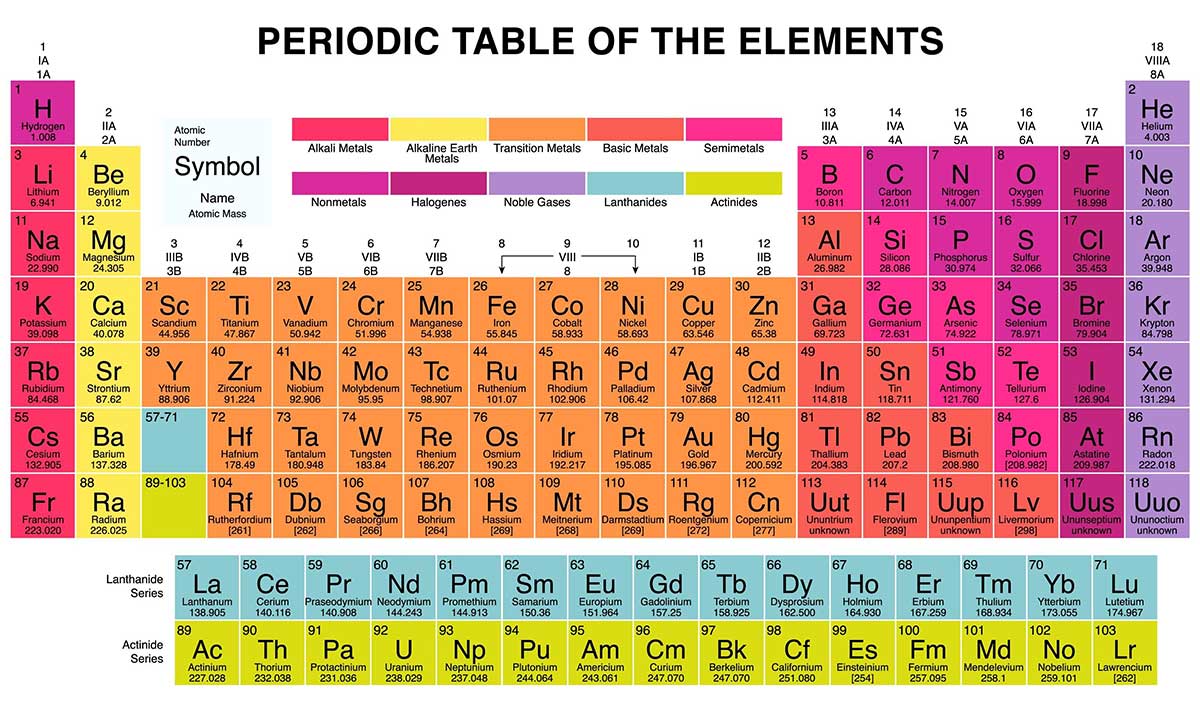The world of Periodic Table and chemical elements has always been very attractive to me. Elements is the simplest forms of matter and Dmitri Mendeleev devised a way to organize them in a tabular form. Each of these elements have unique properties and there are a lot of interesting facts associated with Periodic Table and chemical elements. Today, we will tell you some of the very interesting fun and cool facts about elements. Take a plunge and learn while you have fun!
Facts about Elements and Periodic Table
- As of now, there are a total of 118 elements in the Periodic table.
- First element is Hydrogen (H) and last element is Oganesson (Og).
- Russian chemist Dmitri Mendeleev created the original Periodic Table. In Mendeleev’s table elements were organized according to their increasing atomic weight — the modern Periodic Table arranges elements with increasing atomic number.
- International Union of Pure Applied Chemistry, IUPAC, is an international organization that manages the Periodic Table.
- Hydrogen (H) is the most abundant element in the universe. It makes about 75% of the all observable universe.
- Helium is the second most abundant element in the universe. Hydrogen and Helium, together make over 99% of the observable universe.
- Technetium (Tc) was the first element to be artificially produced. It was first synthesized in 1937.
- J is the only letter missing from all the symbols of periodic table elements.
- Number 113, 115, 117, and 118 are the four elements most recently named. On 28 November 2016, the International Union of Pure and Applied Chemistry approved the name and symbols for these elements as Nihonium (Nh), Moscovium (Mc), Tennessine (Ts), and Oganesson (Og).
- Is Thor your favorite superhero? Well, Thorium (Th) is named after Nordic god of thunder — Thor!
- Although Helium (He) is present on Earth — it was discovered by observing the Sun!
- Richard Feynman, the famous physicist, predicted that Periodic Table can not go beyond 137 elements. Reason? Well, theoretically electrons of element number 137 will spin around its nucleus at the speed of light. So, this mean electrons of element number 138 will move at a speed higher than that of light — which is not possible.
- The rows of the Periodic Table are called periods. An element’s period number is the highest unexcited energy level for an electron of that element.
- Columns of elements help to distinguish groups in the Periodic Table. Elements within a group share several common properties and often have the same outer electron arrangement.
- Fluorine (F) is the most electro-negative element in the Periodic Table. This means Fluorine highly attract electrons towards it.
- Francium (Fr) is the most electro-positive element in the Periodic Table.
- Carbon (C) is unique in that it is known to form up to 10 million different compounds.
- Astatine (At) is the rarest naturally occurring element in the Earth’s crust.
- Did you know which element makes most of your body? It is Oxygen! Oxygen (O) is the most abundant element in human body.
- Which is the most reactive element? Well, it is Fluorine (F).
- Osmium (Os) has the highest density among all elements.
- Iridium (Ir) is the least corrosive element — it means it is least bothered about reaction with water, acid, air or other chemicals.
- There are only two liquid elements in the Periodic Table. These Mercury (Hg) and Bromine (Br). They remain in liquid form at room temperature.
- The heaviest naturally occurring element is Uranium (U) with atomic number 92 and atomic weight 238.0289.
- Many elements have been named after Nobel Prize winning scientists. For example:
- Bohrium (Bh) named after Niels Bohr
- Curium (Cm) named after Marie Curie and Pierre Curie
- Einsteinium (Es) named after Albert Einstein
- Fermium (Fm) named after Enrico Fermi
- Lawrencium (Lr) named after Ernest Lawrence
- Roentgenium (Rg) named after Wilhelm Röntgen
- Rutherfordium (Rf) named after Ernest Rutherford
- Seaborgium (Sg) named after Glenn T. Seaborg
- Some elements have also been named after scientists who did not win Nobel Prize:
- Copernicium (Cn) named after Nicolaus Copernicus
- Meitnerium (Mt) named after Lise Meitner
- Mendelevium (Md) named after Dmitri Mendeleev
- Nobelium (No) named after Alfred Nobel
- Several elements draw their names from places on Earth. For example:
- Polonium (Po) named after Poland
- Francium and Gallium, both named after France
- Nihonium (Nh) named after Japan
- Germanium named for Germany
- Americium named after the Americas
- Europium named after Europe
- Origin of the symbols of some elements is in non-English languages. For example:
- Lead (Pb) is derived from plumbum in Latin
- Tungsten (W) is derived from wolfram in German
- Helium (He) is derived from hḗlios in Greek meaning ‘sun’
- Gold (Au) is derived from aurum in Latin

Use the citation below to add this article to your bibliography
"Periodic Table: Interesting Fun Facts about Elements." Dashamlav.com. Web. 11 June 2025. <https://dashamlav.com/periodic-table-elements-facts/>
Dashamlav.com, "Periodic Table: Interesting Fun Facts about Elements." Accessed 11 June 2025. https://dashamlav.com/periodic-table-elements-facts/
"Periodic Table: Interesting Fun Facts about Elements." (n.d.). Dashamlav.com. Retrieved 11 June 2025 from https://dashamlav.com/periodic-table-elements-facts/
